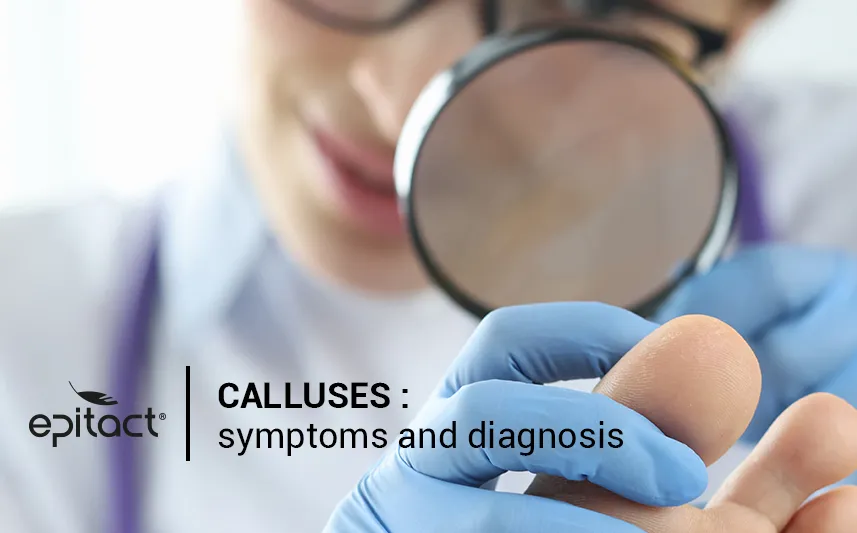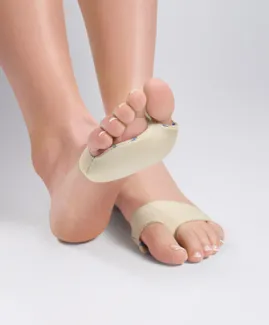
Because of excessive and daily use, the feet face many problems. Among them, the callus, which is a frequent and most of the time benign condition, should be differentiated from other similar foot problems. For this reason, EPITACT® gathers the core callus symptoms and useful information for the diagnosis of such skin problems.
The benign aspect of a callus shouldn’t be a reason to ignore it! It deserves proper care. Who to consult and how to diagnose it? What does a callus look like? What are the main symptoms of a callus?
What does a callus look like?
The callus forms by hyperkeratosis and reaches the upper layers of the skin. In other words, it is caused by excessive frictions and pressures on the plantar surface. To protect from external aggressions, the skin defends by forming a thick and strong shield. The skin thickens, hardens: this is hyperkeratosis.
Let’s remember that in adults, sportspersons, older or diabetic people are particularly prone to this skin thickening. The callus looks like round, thickened and hard areas of skin.
What are the symptoms of a callus?
The callus has very few symptoms. However, this callosity has specific characteristics compared with other hyperkeratotic lesions of the foot (especially corns and soft corns). Then it can be useful to identify the typical signs and symptoms of a callus that allow to differentiate it:
Redness
The surrounding skin of this thick area can be red, a sign of skin irritation.
Skin thickening
This symptom is the first warning sign of a callus formation. This thickening is similar to several callosities (e.g.: corns), but in the case of a callus, some features allow to recognise it easily.
- Its location: the callus forms in the feet or hands. In the hands, it mainly appears in the palm or fingers. In the feet, it generally forms on the ball of the foot, more precisely under the bony protrusions at the base of the toes. Indeed, these areas are more so exposed to excessive pressures during walking.
- The size: calluses on the bottom of the foot can have variable sizes.
- Its shape: often round-shaped, the callus can also adopt variable forms.
- Its colour: generally, the callus has a yellowish colour.
- The appearance: the callus looks like thick skin which is relatively hard and rough. Indeed, the skin covering the affected area is similar to horn and is very dry.
Pain
Let’s note that this callus symptom isn’t frequent. Most of the time, a callus is painless, but it can cause discomfort and even pain while walking. Depending on its precise location and the intensity of activities (e.g. doing a lot of walking), the callus can create a real discomfort.
For all these reasons, and as benign as it may be, it should be cared for and treated in the long term. A health professional should diagnose it. In addition to facilitating healing, the advice of a specialist is essential to prevent the recurrence or the formation of calluses.
How to diagnose a callus?
Now you know what a callus looks like. The few symptoms of a callus are well-recognisable.
1) At first, the health professional observes the affected area. In general, this visual inspection is sufficient to identify a callus and no further clinical examination is necessary.
2) If he suspects an underlying condition, the specialist will also inspect the posture of the body and feet. Indeed, malformations of the foot such as hallux valgus (bunion), flat foot or claw/hammer toes can favour calluses as they cause poor distribution of loads under the forefoot..
As a result, a long-lasting treatment for a callus is mediated by the identification and elimination of its causes as soon as possible.
3) Lastly, the inspection is completed with some questions. The specialist asks you some specific questions to take your medical history, after which he determines the differential diagnoses of your foot condition.
Indeed, the objective of the clinical examination is to establish the proper diagnosis by eliminating the potential conditions that look like a callus. As the callus symptoms and signs are similar to other foot problems, this step is important. Among the differential diagnoses, let’s cite corns, soft corns but also plantar warts.
Who and when to consult?
Do not remove a callus yourself and see a health professional. Your physician or podiatrist are both specialists you can consult if you have calluses. They are particularly able to identify the potential underlying conditions or malformations of the foot. They also provide you all the information necessary to avoid recurrence by determining the exact cause of your callus.
Another advantage: they inform you about the possible complications of a callus. One of the rare and dangerous complications of callosities like corns and calluses is infection. Diabetic people should be particularly careful regarding this complication risk.
Loss of sensitivity caused by diabetes, plus the painful aspect of a callus can delay the identification of a foot condition. This can also lead to a much more severe condition bearing the name of perforating ulcer of the foot...
Solutions for calluses
Orthopaedic solutions can relieve your pain by limiting rubbing and pressures on your feet. For example, the metatarsal pads* efficiently soothe the bottom of the forefoot. These protections limit pressures, frictions and instability effects. With just 2 mm of thickness, they are really comfortable while walking and help the disappearance of calluses.
If you were wondering what a callus looks like, you know now how to recognise it. Calluses are commonly easy to treat, so do not let them gain ground! You’d avoid useless and uncomfortable sensations and pain that may ruin your trips. Identifying the causes of this foot condition is the first step to prevent the callus symptoms and treat them permanently.
*These solutions are class I medical devices that bear the CE marking under this regulation. Carefully read the instructions before use. Manufacturer: Millet Innovation. 09/2021
 Pharmacie
Pharmacie